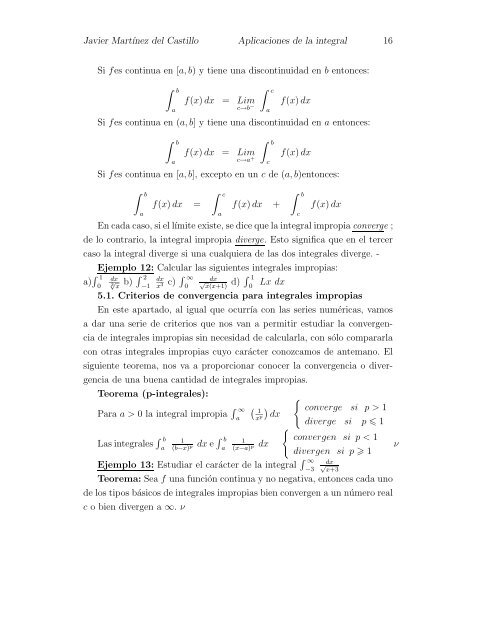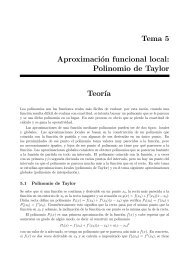Cap´ıtulo 1 Aplicaciones de la integral
Cap´ıtulo 1 Aplicaciones de la integral
Cap´ıtulo 1 Aplicaciones de la integral
You also want an ePaper? Increase the reach of your titles
YUMPU automatically turns print PDFs into web optimized ePapers that Google loves.
Javier Martínez <strong>de</strong>l Castillo <strong>Aplicaciones</strong> <strong>de</strong> <strong>la</strong> <strong>integral</strong> 16<br />
Si fes continua en [a,b) y tiene una discontinuidad en b entonces:<br />
b<br />
a<br />
f(x)dx = Lim<br />
c→b −<br />
c<br />
a<br />
f(x)dx<br />
Si fes continua en (a,b] y tiene una discontinuidad en a entonces:<br />
b<br />
a<br />
f(x)dx = Lim<br />
c→a +<br />
b<br />
c<br />
f(x)dx<br />
Si fes continua en [a,b], excepto en un c <strong>de</strong> (a,b)entonces:<br />
b<br />
a<br />
f(x)dx =<br />
c<br />
a<br />
f(x)dx +<br />
b<br />
c<br />
f(x)dx<br />
En cada caso, si el límite existe, se dice que <strong>la</strong> <strong>integral</strong> impropia converge ;<br />
<strong>de</strong> lo contrario, <strong>la</strong> <strong>integral</strong> impropia diverge. Esto significa que en el tercer<br />
caso <strong>la</strong> <strong>integral</strong> diverge si una cualquiera <strong>de</strong> <strong>la</strong>s dos <strong>integral</strong>es diverge. -<br />
a) 1<br />
0<br />
Ejemplo 12: Calcu<strong>la</strong>r <strong>la</strong>s siguientes <strong>integral</strong>es impropias:<br />
dx<br />
3√ b) x 2<br />
−1<br />
dx<br />
x3 c) ∞<br />
0<br />
√ dx d) x(x+1) 1<br />
0<br />
Lx dx<br />
5.1. Criterios <strong>de</strong> convergencia para <strong>integral</strong>es impropias<br />
En este apartado, al igual que ocurría con <strong>la</strong>s series numéricas, vamos<br />
a dar una serie <strong>de</strong> criterios que nos van a permitir estudiar <strong>la</strong> convergen-<br />
cia <strong>de</strong> <strong>integral</strong>es impropias sin necesidad <strong>de</strong> calcu<strong>la</strong>r<strong>la</strong>, con sólo comparar<strong>la</strong><br />
con otras <strong>integral</strong>es impropias cuyo carácter conozcamos <strong>de</strong> antemano. El<br />
siguiente teorema, nos va a proporcionar conocer <strong>la</strong> convergencia o diver-<br />
gencia <strong>de</strong> una buena cantidad <strong>de</strong> <strong>integral</strong>es impropias.<br />
Teorema (p-<strong>integral</strong>es):<br />
Para a > 0 <strong>la</strong> <strong>integral</strong> impropia ∞<br />
a<br />
Las <strong>integral</strong>es b<br />
a<br />
1<br />
(b−x) p dx e b<br />
a<br />
<br />
1<br />
xp <br />
dx<br />
<br />
1<br />
(x−a) p dx<br />
Ejemplo 13: Estudiar el carácter <strong>de</strong> <strong>la</strong> <strong>integral</strong> ∞<br />
−3<br />
<br />
converge si p > 1<br />
diverge si p 1<br />
convergen si p < 1<br />
divergen si p 1<br />
dx<br />
√ x+3<br />
Teorema: Sea f una función continua y no negativa, entonces cada uno<br />
<strong>de</strong> los tipos básicos <strong>de</strong> <strong>integral</strong>es impropias bien convergen a un número real<br />
c o bien divergen a ∞. ν<br />
ν




